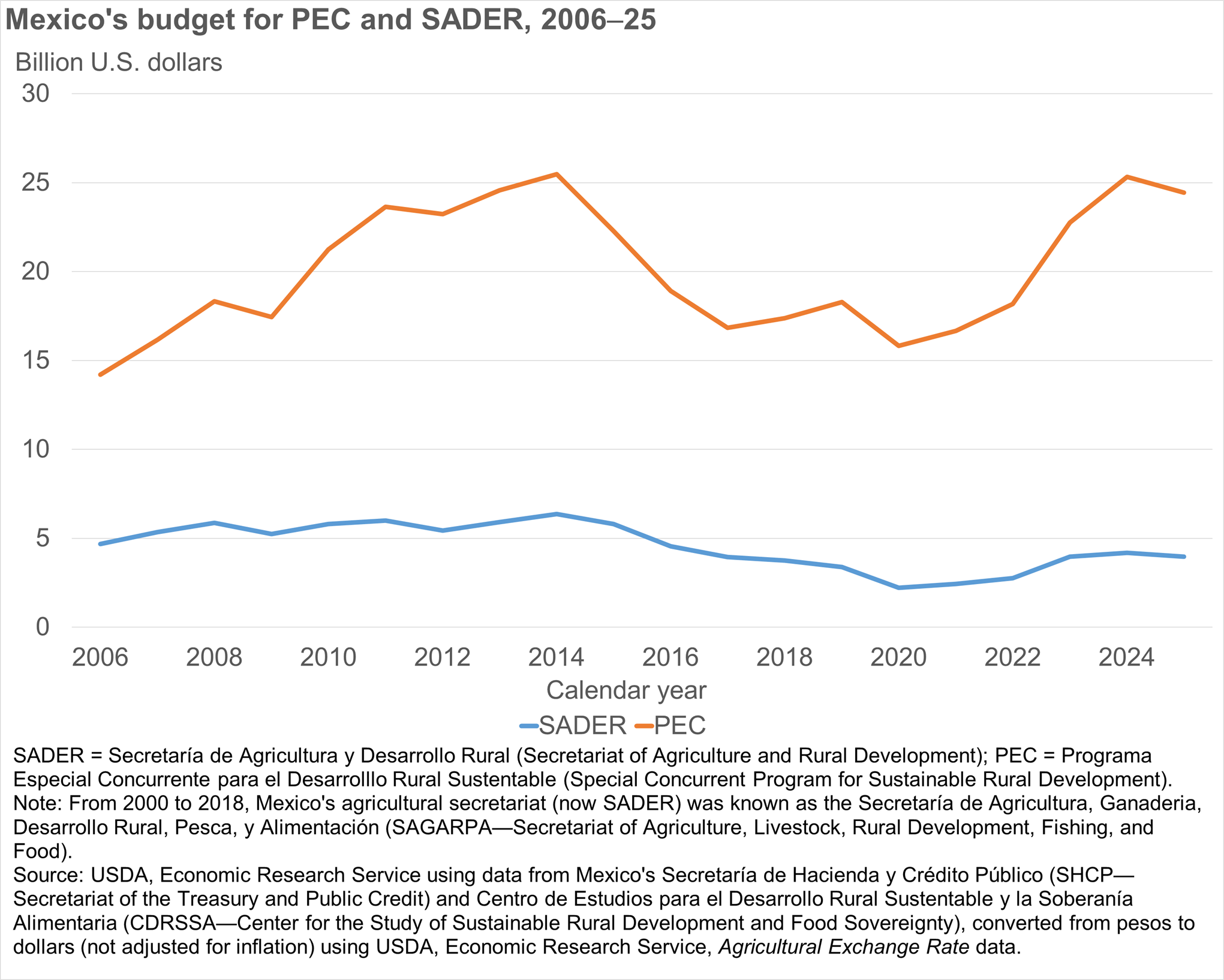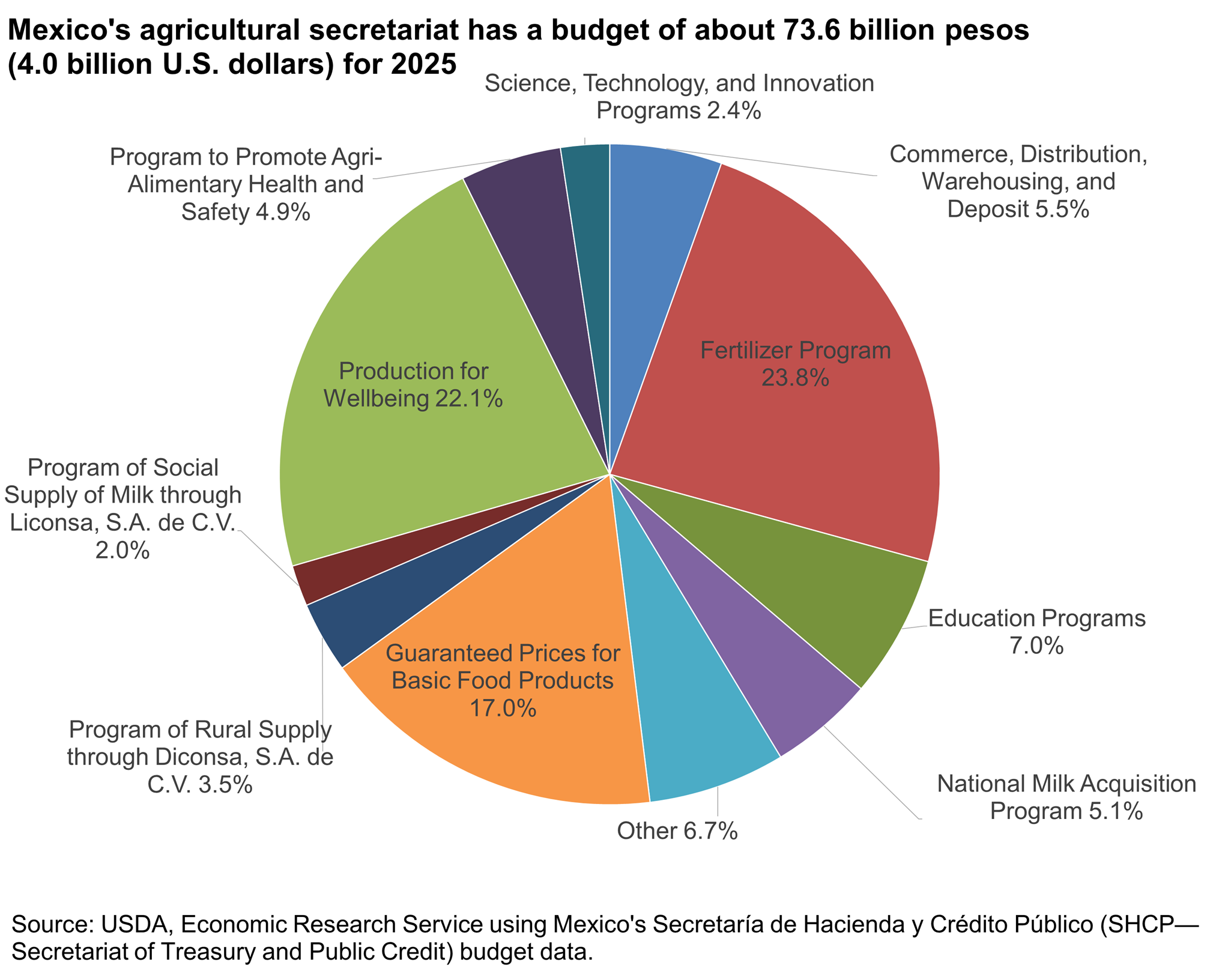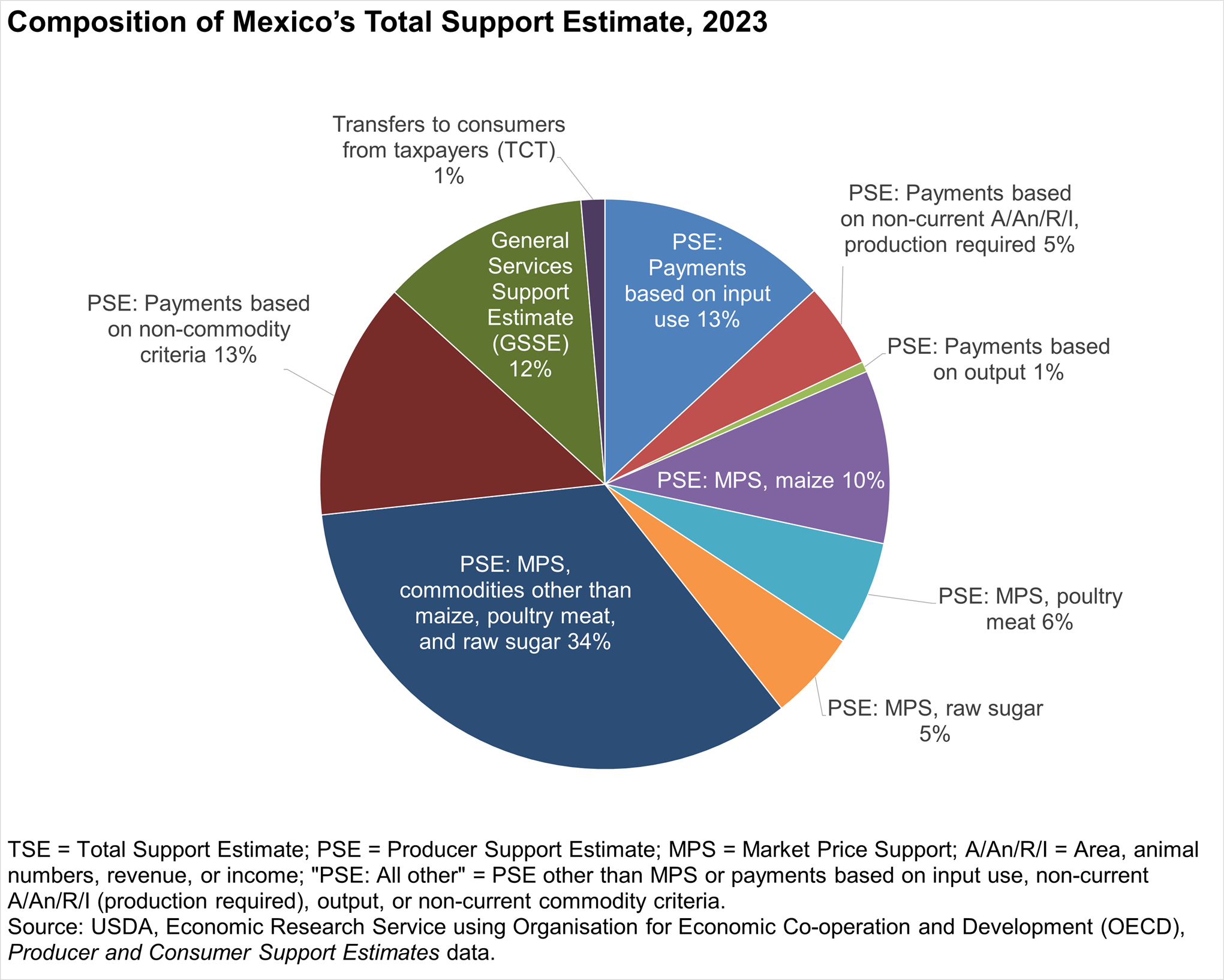SADER and the Special Concurrent Program for Sustainable Rural Development
Agricultural Finance
OECD Support Estimates
Mexico’s agricultural programs reflect the heterogeneity of the country’s agricultural sector. Producers range from large commercial operations to small, subsistence-oriented farms. Accordingly, some Mexican farm programs are designed for advanced commercial operations, others for less developed operations, and still others for virtually all producers. Like its predecessor, Mexico’s current presidential administration (2024–30) has emphasized policy initiatives focused on small- and medium-scale farmers. This reorientation of the Mexican Government’s activities concerning agriculture was accompanied by a reallocation of resources toward activities dedicated to small- and medium-scale producers.
SADER and the Special Concurrent Program
The Special Concurrent Program for Sustainable Rural Development (PEC—Programa Especial Concurrente para el Desarrollo Rural Sustentable) is a budgetary instrument the Mexican Government uses to plan and implement its activities in the areas of agriculture and rural development. PEC covers activities implemented by several cabinet ministries, including the Secretariat of Agriculture and Rural Development (SADER—Secretaría de Agricultura y Desarrollo Rural), Mexico’s counterpart to USDA.
When measured in nominal U.S. dollars—i.e., not adjusted for inflation—PEC’s overall budget dropped to 15.8 billion U.S. dollars in 2020 due to the economic downturn resulting from the COVID-19 pandemic and then increased to 25.3 billion U.S. dollars by 2024. Similarly, SADER’s budget fell to 2.2 billion U.S. dollars in 2020 and then grew to 4.2 billion U.S. dollars by 2024. For 2025, a budget of 24.4 billion U.S. dollars for PEC and 4.0 billion U.S. dollars for SADER has been proposed.

Download chart data in Excel format
For 2025, a budget of about 73.6 billion pesos (4.0 billion U.S. dollars) has been proposed for SADER. A little more than half (54.8 percent) of this budget is dedicated to three programs:
- The Fertilizer Program accounts for 23.8 percent of the budget. This program seeks to promote national food security by providing up to 600 kilograms of fertilizer per producer to qualifying small-scale growers of corn, dry beans, rice, and other crops of high economic or social impact.
- The Production for Wellbeing Program (Producción para el Bienestar) accounts for 22.1 percent of the budget. This program channels direct payments and technical assistance to producers of corn, dry beans, honey, amaranth, rice, cocoa, coffee, sugarcane, chia, milk, prickly pear, sorghum, and wheat. For 2024, the payment rates for grain farmers ranged from 6,200 to 10,000 pesos per producer (about 350 to 564 U.S. dollars per farmer, using the nominal exchange rate for that year), depending on farm size and access to irrigation.
- The Guaranteed Prices for Basic Food Products Program accounts for 17.0 percent of the budget. Under this program, the Mexican Government established guaranteed prices and/or incentives for the production for corn, dry beans, rice, wheat for bread, and milk—but limited the products' availability to small-and medium-scale producers and specified quantities of production.

Download chart data in Excel format
Agricultural Finance
In agricultural finance, Mexico relies on two domestic Government financial institutions to augment the activities of the commercial banking sector:
- Funds Instituted in Relation with Agriculture (FIRA—Fideicomisos Instituidos en Relación con la Agricultura); and
- Capitalization and Investment Fund of the Rural Sector (FOCIR—Fondo de Capitalización e Inversión del Sector Rural).
A third Government institution engaged in agricultural finance, the National Financier of Agricultural, Rural, Forestry, and Fishing Development (FND—Financiera Nacional de Desarrollo Agropecuario, Rural, Forestal, y Pesquero), was dissolved in 2023.
FIRA was created in 1954 by the Mexican Government to offer credits, guarantees, training, technical assistance, and support of technology transfer to Mexico’s agricultural, forestry, fishery, and rural sectors. This Government-owned fund is managed by Banco de México (Mexico’s central bank) and operates as a second-tier lender through a wide range of financial intermediaries. These intermediaries include banks, Multi-Purpose Financial Societies (SOFOMES—Sociedades Financieras de Objeto Múltiple), credit unions, warehouse companies, Popular Financial Societies (SOFIPOS—Sociedades Financieras Populares), and Cooperative Societies of Savings and Loans. Additionally, FIRA offers support in the form of business training, technical assistance, consulting, technology transfer, and strengthening of skills.
FIRA’s Institutional Plan for 2020–24 (as described in its 2023 annual report) outlines three priority objectives: (1) financial inclusion; (2) productivity and efficiency; and (3) sustainability. Within the financial inclusion objective in 2023, about 2.1 million of FIRA’s 2.3 million borrowers were “microempresas”—small-scale firms with not more than 10 employees and annual income not more than 4 million pesos—about 225,000 U.S. dollars, using the nominal exchange rate for 2023. To foster productivity and efficiency within Mexico’s agricultural, forestry, fishing, and rural sectors, FIRA lent a total of 341.4 billion pesos (19.2 billion U.S. dollars) for agricultural and rural financing, a real increase of 35 percent from 2015. FIRA designated 19.9 billion pesos (1.1 billion U.S. dollars) in 2023 to projects for managing environmental risks, promoting sustainable investments, efficiently using natural resources, and circulating best practices, and to other activities related to environmental sustainability. In response to the Coronavirus (COVID-19) pandemic, FIRA added a fourth priority objective: maintaining financial sustainability and institutional capacity. In pursuit of this objective, FIRA has aimed to maintain the real (inflation-adjusted) value of its assets at the level observed at the close of 2018.
FOCIR’s mission is to “contribute to the development of the rural and agro-industrial sector in a sustainable manner, through long-term investment that triggers projects with high potential and social benefit.” FOCIR’s 2020 annual report indicated FOCIR contributes to a set of six agribusiness investment funds—used “to trigger sustainable productive projects, the development of technical, productive, and commercial capacity, and the integration of local circuits of production, marketing, investment, and financing.” Among FOCIR’s main activities are to promote long-term investments through the Agribusiness Capital Investment Funds (FICA—Fondos de Inversión de Capital en Agronegocios) and to act as an institutional investor in projects favoring rural and agribusiness development via Capital Investment Financial Intermediaries as a Limited Partner and/or Adherent Trustor (Intermediarios Financieros de Inversión de Capital como Socio Limitado y/o Fideicomitente Adherente). In both activities, FOCIR acts as a temporary, minority partner (7–10 years, not more than 35 percent). At the close of 2023, FOCIR had a balance of temporary investments, funds with specific purposes, and checking accounts—all totaling about 1.7 billion pesos (98 million U.S. dollars). FOCIR is part of Mexico’s Secretariat of Treasury and Public Credit (Secretaría de Hacienda y Crédito Público).
OECD Support Estimates
Agricultural support estimates calculated by the Organization of Economic Cooperation and Development (OECD) provide a common framework for evaluating the size of government support to agriculture. The Total Support Estimate (TSE) measures “the annual monetary value of all gross transfers from taxpayers and consumers arising from policy measures that support agriculture, net of the associated budgetary receipts, regardless of their objectives and impacts on farm production and income, or consumption of farm products.” In 2023, Mexico’s TSE totaled about 275.3 billion pesos (15.5 billion U.S. dollars). This estimate includes some agriculture-related activities that took place outside of SADER, and the estimate does not cover some activities of SADER that OECD does not count as government support to agriculture.
The TSE has three components:
- The Producer Support Estimate (PSE), “the annual monetary value of gross transfers from consumers and taxpayers to support agricultural producers, measured at farm gate level”;
- The General Services Support Estimate (GSSE), “the annual monetary value of gross transfers to general services provided to agricultural producers collectively (such as research, development, training, inspection, marketing, and promotion)”; and
- Transfers to Consumers from Taxpayers (TCT), the “annual monetary value of gross transfers to consumers of agricultural commodities, measured at the farm gate level, arising from policy measures that support agriculture, regardless of their nature, objectives, or impacts on consumption of farm products.”
Of Mexico’s 2023 Total Support Estimate, PSE accounted for 86.8 percent, GSSE accounted for 11.9 percent, and TCT accounted for 1.3 percent.

Download chart data in Excel format
The leading forms of agricultural support in Mexico are: (1) support based on commodity outputs (55.3 percent of 2023 TSE); and (2) payments based on non-commodity criteria (13.5 percent of 2023 TSE). Market Price Support (MPS) accounted for about 54.8 percent of TSE and 98.9 percent of support, based on commodity outputs in 2023. MPS is calculated “by adding together the price transfers to producers from consumers and taxpayers, minus the contribution that producers make to these transfers.” For an individual commodity, these price transfers are estimated by multiplying the Market Price Differential (MPD) by the quantity of domestic supply, where the MPD is the difference between the domestic market price and the border price of the commodity, measured at the farm gate level. In 2023, maize accounted for 17.9 percent of Mexico’s MPS, poultry meat accounted for 10.8 percent, and raw sugar accounted for 9.3 percent. Tariffs on agricultural imports and guaranteed prices for maize, wheat, rice, and milk are the main policies corresponding to Mexico’s MPS.
Another way to consider the level of Mexico’s support to agriculture is to compare Mexico’s support with the value of the country’s agricultural production, using a measure called the Percentage Producer Support Estimate (PSE). PSE equals the amount of producer support divided by the sum of transfers from taxpayers to producers plus the value of agricultural production, expressed as a percentage. During calendar years 2019–23, Mexico’s PSE ranged from 7 to 14 percent, compared with 6 to 11 percent for the United States and 12 to 17 percent for the OECD countries as a whole.
Click here for data on Mexico's Total Agricultural Support Estimate, 2014-2023
